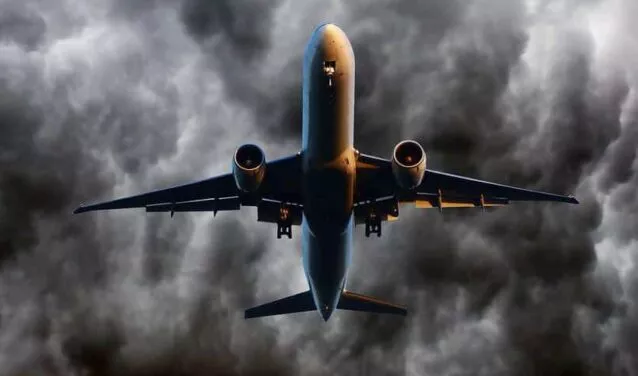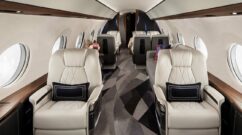
“Please fasten your seatbelts, we’re about to hit some turbulence. You’ve probably heard this announcement from the captain during a flight. It’s usually followed by a few jolts, or a feeling of falling into the void following an “air pocket”… But do you know the origin of turbulence? While turbulence can sometimes seem like the end of the world to some people, statistically speaking, there is no record of a plane crash caused by turbulence. Here’s why you shouldn’t fear turbulence:
In this article, we explain what they really are, why they happen, and above all why they shouldn’t worry you.
what is turbulence?
Atmospheric turbulence is a temporary disturbance in an aircraft’s flight path.
In other words, it’s a variation in wind direction and intensity that disrupts the aircraft’s stability.
This leads to vertical or horizontal acceleration, causing the aircraft to jerk or move abruptly, to varying degrees of severity.
But rest assured, this manageable situation has no impact on flight safety.
What are the main causes of turbulence?
turbulence can have several origins, generally classified into three categories: geographical, meteorological and mechanical.
1. Geographical causes
Mountainous terrain influences not only the Earth’s surface, but also the movement of air masses.
Like a river that encounters “obstacles” and changes course, air can be disturbed when it collides with mountains, creating turbulence.
Certain areas are therefore more exposed to this phenomenon, notably airports located close to mountain ranges.
For example, if you’re flying over Europe, you’re likely to experience turbulence as you pass over the Alps.
2. Meteorological causes
Air is constantly in motion, with different currents flowing through it: warm air masses rising, and colder ones descending.
This phenomenon, known as convection, generates vertical air movements. When an aircraft encounters a downdraft, it can lose several dozen meters of altitude.
This sudden variation gives passengers the impression that the aircraft is “falling”, an often unpleasant sensation commonly referred to as an “air pocket”.
3. Mechanical causes
In rare cases, turbulence can be caused by the aircraft itself. This happens mainly during take-off and landing.
At this point, the air flowing around the wingtips forms small vortices known as “wake turbulence”.
These phenomena are well known to pilots, and are taken into account in flight procedures to ensure safety.

Photo credit: Pixabay
Is turbulence dangerous?
Although uncomfortable, turbulence is not dangerous. It’s a normal, even natural phenomenon that poses no threat to passenger safety. There are two main reasons why you shouldn’t fear turbulence in flight:
1. Aircraft are designed to withstand such phenomena
Firstly, aircraft manufacturers design aircraft to withstand all forms of external pressure and risk.
Aircraft undergo robust resistance tests at both high and low weights. What’s more, a plane will never break down due to turbulence.
Finally, in the event of disturbances, the different aircraft structures minimize the impact of turbulence during flight, thanks to vibration-absorbing wings.
2. Pilots are trained to anticipate disturbance zones
Pilots are very early to learn about meteorology and atmospheric turbulence. When preparing a flight, pilots file a flight plan which can be modified in the event of turbulence.
What’s more, they are aided by on-board technologies that can detect areas of turbulence in flight and avoid them. Finally, from the pilot’s point of view, turbulence is more of a customer service issue than a safety one.
Pilots aren’t worried about the aircraft being damaged, they’re just concerned about keeping the best experience for their customers and the beverages in place.
So rest assured, if you’re flying into turbulence, you’re safe.
Which areas of the world are most prone to turbulence?
Certain regions of the globe are more prone to turbulence, due to their geographical configuration or particular atmospheric phenomena. Here are the main ones to be aware of:
- Mountain ranges: the Alps, the Rockies, the Himalayas and the Andes generate what are known as “orographic waves”, which disrupt air masses and generate frequent turbulence.
- Equatorial zones: Intense heat leads to strong updrafts and the regular formation of tropical thunderstorms, especially over Central Africa, South America and Southeast Asia.
- Jet streams: These are fast-moving winds at high altitude. Aircraft crossing these areas, particularly over the North Atlantic or North Pacific, may encounter “clear” turbulence (with no visible clouds).
- Coastal and oceanic areas are exposed to winds: For example, the Cape region of South Africa or the Japanese coast can be subject to sudden wind variations.
Good to know: Pilots know these areas inside out, and adapt their flight paths to maximize onboard comfort.
Turbulence and aircraft types: what you need to know
Not all aircraft react in the same way to turbulence. Several factors influence the sensation experienced in flight:
- Larger aircraft (e.g. Airbus A350, Boeing 777): Thanks to their greater weight and wingspan, these aircraft offer greater stability in flight. Jolts are generally attenuated.
- Modern private jets (e.g. Gulfstream G700, Falcon 10X): These top-of-the-range aircraft feature advanced stabilization technologies and flight management systems to avoid turbulent zones. They offer a particularly smooth flying experience.
- Small aircraft or turboprops: Less heavy and more sensitive to air movements, they can accentuate the perception of turbulence, although they remain just as safe.
Comfort tip: An aircraft’s center of gravity is at wing level. Choosing a seat at this point can reduce the sensation of shaking.
Practical tips for coping with turbulence
Although turbulence is harmless, it can cause discomfort and anxiety for some passengers. Here are a few tips to help you cope more serenely:
- Always keep your seatbelt fastened, even when the signal is off.
- Listen to relaxing music, a podcast or guided meditation to divert your attention.
- Avoid alcohol and caffeine, which can increase anxiety.
- Choose a morning flight: the atmosphere is generally more stable, with fewer thermal movements.
If you don’t mind, talk to the flight crew. Their calm and professionalism can reassure you.
Why choose a private jet for greater comfort in turbulent conditions?
Private jets offer not only time savings and flexibility, but also a more comfortable flying experience, even in turbulent conditions.
Here are just a few of the benefits:
- Quiet, pressurized cabins designed to dampen buffeting.
- Latest-generation flight stabilization technologies.
- Customized itineraries: the pilot can adjust altitude or change course in real time to avoid disturbed areas.
- Less waiting on the ground, so less overall pre-flight stress.
Travel with peace of mind with AEROAFFAIRES
Since 1991, AEROAFFAIRES has specialized in private jet rental and business aviation. Our pilots are experienced, our aircraft certified, and we place the safety and comfort of our passengers at the heart of our priorities.
Some key figures:
- 20,000 aircraft available worldwide
- 45,000 flights organized since our creation
- 120,000+ passengers carried
- 100% carbon offset
- Average satisfaction rating: 4.9/5
In a nutshell
Turbulence may be unpleasant, but it’s neither rare nor dangerous. Thanks to our robust aircraft and experienced pilots, you can travel with a clear head, even in turbulent skies.
At AEROAFFAIRES, we do our utmost to ensure that your flying experience remains synonymous with comfort, efficiency and peace of mind.
Our advisors are at your disposal for further information. Our teams are available 24/7 to answer all your questions.
Get your quote online now, or contact us on +33 (0)1 44 09 91 82.






